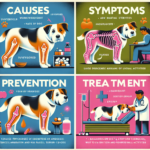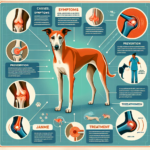Russell Terrier Joint Pain: Causes, Symptoms, Prevention, and Treatment

Introduction
The Russell Terrier, also known as the Jack Russell Terrier, is a small, energetic breed known for its intelligence, agility, and spirited personality. Originating from England in the 19th century, this breed was initially developed for fox hunting. The Russell Terrier is characterized by its compact size, muscular build, and a coat that can be smooth, rough, or broken. Despite their small stature, these dogs are known for their high energy levels and require ample physical and mental stimulation.
Like many breeds, Russell Terriers are prone to certain health issues, including joint pain. Joint health is particularly crucial for this breed due to their active lifestyle and high energy levels. Ensuring that a Russell Terrier maintains healthy joints can significantly impact their quality of life and longevity.
Breed-Specific Joint Pain Risks
Genetic Predisposition
Russell Terriers, like many purebred dogs, have a genetic predisposition to certain joint-related issues. Common conditions include hip dysplasia, arthritis, and elbow dysplasia. Hip dysplasia occurs when the hip joint does not fit into the hip socket properly, leading to pain and mobility issues. Arthritis, a degenerative joint disease, can also affect Russell Terriers, causing inflammation and pain in the joints. Elbow dysplasia, a condition where the elbow joint develops abnormally, can lead to chronic pain and lameness.
Age-Related Risks
As Russell Terriers age, the risk of developing joint pain increases. While younger dogs may not show symptoms, older dogs are more likely to experience joint issues. Typically, signs of joint pain may start to appear around the age of 7 or 8, although this can vary depending on the individual dog and its overall health.
Activity Level and Joint Stress
Russell Terriers are known for their high activity levels and love for physical activities such as running, jumping, and playing. While regular exercise is essential for their overall health, excessive or high-impact activities can put stress on their joints, potentially leading to joint pain over time. Owners should be mindful of the types and intensity of activities their Russell Terrier engages in to prevent undue joint stress.
Common Symptoms of Joint Pain in Russell Terriers
General Symptoms
- Limping or favoring one leg
- Stiffness, especially after rest or sleep
- Reluctance to move, jump, or climb stairs
- Decreased activity or playfulness
- Visible discomfort or pain when touched
- Swelling around the joints
Breed-Specific Symptoms
In Russell Terriers, joint pain may manifest more noticeably due to their typically high energy levels. A sudden decrease in activity or reluctance to engage in previously enjoyed activities can be a significant indicator of joint pain. Additionally, due to their small size, even minor changes in movement or behavior can be more apparent to observant owners.
When to Consult a Vet
If a Russell Terrier exhibits any of the symptoms mentioned above, it is crucial to consult a veterinarian promptly. Early diagnosis and intervention can help manage joint pain more effectively and improve the dog’s quality of life. Regular veterinary check-ups are also essential for monitoring joint health and catching any issues early.
Preventive Measures for Joint Health
Exercise Recommendations
Regular, moderate exercise is vital for maintaining joint health in Russell Terriers. Activities such as walking, swimming, and controlled play can help keep their joints flexible and muscles strong without causing excessive stress. Avoid high-impact activities like jumping from heights or running on hard surfaces, as these can exacerbate joint issues.
Dietary Suggestions
A balanced diet rich in essential nutrients can support joint health in Russell Terriers. Foods containing glucosamine, chondroitin, and omega-3 fatty acids are particularly beneficial for joint health. These nutrients can help reduce inflammation and support cartilage health. Owners may also consider joint supplements, but it is essential to consult a veterinarian before adding any supplements to the dog’s diet.
Weight Management
Maintaining a healthy weight is crucial for reducing joint stress in Russell Terriers. Excess weight can put additional pressure on the joints, exacerbating pain and mobility issues. Owners should monitor their dog’s weight and adjust their diet and exercise routine as needed to ensure they remain within a healthy weight range.
Early Screening and Monitoring
Regular veterinary check-ups and early screening for joint issues can help catch problems before they become severe. For Russell Terriers, it is advisable to start joint health screenings at a young age, especially if there is a family history of joint problems. Early intervention can significantly improve the prognosis for dogs with joint issues.
Treatment Options for Joint Pain
Non-Surgical Treatments
Non-surgical treatments for joint pain in Russell Terriers include medications, physical therapy, and lifestyle adjustments. Anti-inflammatory medications and pain relievers can help manage pain and reduce inflammation. Physical therapy, including exercises and massage, can improve joint mobility and strength. Lifestyle adjustments, such as providing a comfortable bed and avoiding high-impact activities, can also help manage joint pain.
Surgical Options
In severe cases of joint pain, surgical intervention may be necessary. Common surgical options for joint issues in Russell Terriers include hip replacement, arthroscopy, and joint fusion. These surgeries can help alleviate pain and improve mobility, but they come with risks and require a significant recovery period. It is essential to discuss the potential benefits and risks with a veterinarian before opting for surgery.
Alternative Therapies
Alternative therapies such as acupuncture, hydrotherapy, and massage can also benefit Russell Terriers with joint pain. Acupuncture can help reduce pain and inflammation, while hydrotherapy provides low-impact exercise that can improve joint mobility and strength. Massage can help relax muscles and improve circulation, providing relief from joint pain.
Lifestyle and Management Tips
Daily Care Routine
A daily care routine for a Russell Terrier with joint pain should include regular, moderate exercise, a balanced diet, and any prescribed medications or supplements. Gentle exercises such as walking or swimming can help maintain joint health without causing excessive stress. Providing a comfortable bed and avoiding high-impact activities can also help manage joint pain.
Modifying the Home Environment
Making the home environment more comfortable for a dog with joint pain can significantly improve their quality of life. Consider using ramps instead of stairs, providing orthopedic beds, and ensuring that food and water bowls are at a comfortable height. These modifications can help reduce joint stress and make daily activities easier for the dog.
Long-Term Management
Long-term management of joint pain in Russell Terriers involves regular veterinary check-ups, ongoing monitoring of joint health, and maintaining a healthy lifestyle. Owners should be vigilant for any changes in their dog’s behavior or mobility and consult a veterinarian if any issues arise. With proper care and management, dogs with joint pain can lead happy, active lives.
FAQs About Russell Terriers and Joint Pain
What are the early signs of joint pain in Russell Terriers?
Early signs of joint pain in Russell Terriers include limping, stiffness, reluctance to move, and decreased activity levels. Owners should watch for any changes in their dog’s behavior or mobility and consult a veterinarian if they notice any symptoms.
Can diet help prevent joint pain in Russell Terriers?
Yes, a balanced diet rich in essential nutrients such as glucosamine, chondroitin, and omega-3 fatty acids can support joint health and help prevent joint pain. Owners should consult a veterinarian for dietary recommendations and consider joint supplements if necessary.
Are there specific exercises that are better for Russell Terriers with joint pain?
Low-impact exercises such as walking, swimming, and controlled play are ideal for Russell Terriers with joint pain. These activities help maintain joint flexibility and muscle strength without causing excessive stress on the joints.
When should I consider surgery for my Russell Terrier’s joint pain?
Surgery should be considered for severe cases of joint pain that do not respond to non-surgical treatments. Common surgical options include hip replacement, arthroscopy, and joint fusion. It is essential to discuss the potential benefits and risks with a veterinarian before opting for surgery.
Can alternative therapies help manage joint pain in Russell Terriers?
Yes, alternative therapies such as acupuncture, hydrotherapy, and massage can help manage joint pain in Russell Terriers. These therapies can reduce pain and inflammation, improve joint mobility, and provide relief from joint pain.
Conclusion
Joint pain is a common issue in Russell Terriers, but with proper care and management, it is possible to maintain their quality of life. Regular exercise, a balanced diet, weight management, and early screening can help prevent joint issues. For dogs already experiencing joint pain, non-surgical treatments, surgical options, and alternative therapies can provide relief. By taking preventive measures and consulting a veterinarian regularly, owners can ensure their Russell Terrier remains active and happy despite joint pain.




